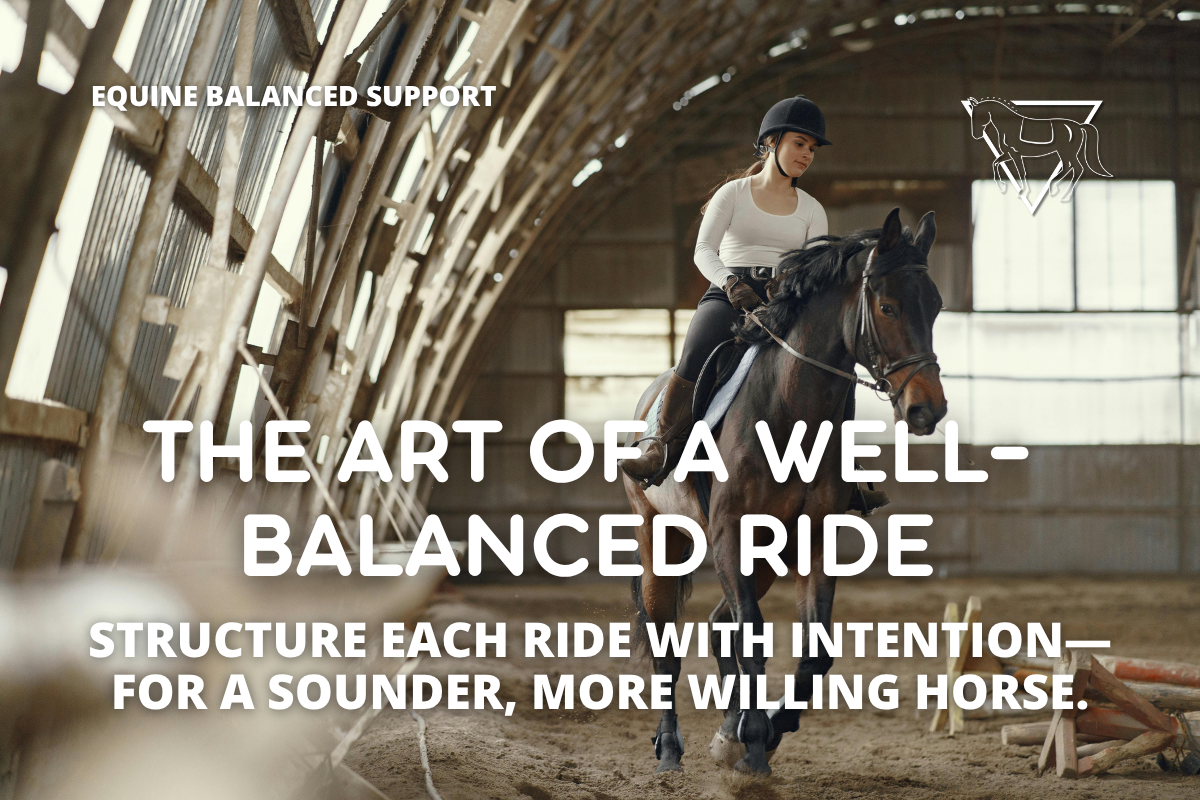The Art of a Well-Balanced Ride: Why Variation and Breaks Matter

The Art of a Well-Balanced Ride: Why Variation and Breaks Matter
One of the most important aspects of practical horse training is structuring each ride to include variation, appropriate warm-up, and well-timed breaks. A thoughtful approach ensures our horses stay engaged, physically comfortable, and mentally receptive to learning. Too often, riders get caught up in "drilling" an exercise rather than progressing with purpose. This risks frustration and increases the chance of physical strain and injury.
The Importance of a Thorough Warm-Up
A proper warm-up sets the foundation for a productive ride. Before asking for serious work, walk on a long rein for 10–20 minutes. This serves multiple purposes:
- It allows muscles to loosen gradually, reducing the risk of stiffness or strain.
- It increases blood circulation, delivering oxygen to working muscles.
- It enables both horse and rider to settle mentally, creating a focused and relaxed atmosphere for the rest of the ride.
Rushing into trot or canter without an adequate warm-up is like asking an athlete to sprint without stretching—it leads to tension, discomfort, and even long-term soundness issues.
The Power of True Breaks
One of the most overlooked but crucial training elements is giving the horse a proper break between work sets—not just a moment of lighter work but an actual period of relaxation on a long rein.
Why are breaks essential?
- Muscle Recovery & Blood Flow – During breaks, circulation improves, delivering oxygen and flushing out metabolic waste. This strengthens muscles over time rather than leaving them in prolonged discomfort.
- Mental Reset – Horses, like humans, need time to process what they've just worked on. Without breaks, frustration and mental fatigue set in, leading to resistance rather than progress.
- Prevention of Physical Tension – If a horse is held in a working frame for too long, the muscles become fatigued, leading to stiffness and potential soreness the next day.
Think of these breaks as "active recovery"—an essential tool for building strength and keeping training rewarding for your horse.
Avoiding the Trap of Over-Drilling
It's easy to fall into the habit of repeating an exercise over and over, hoping for perfection. However, we must ask ourselves:
Am I working toward better understanding and execution? Or am I drilling needlessly?
If an exercise improves within a few repetitions, move on to something else. Repeating the same movement excessively often leads to diminishing returns, frustration, and physical fatigue. Instead, focus on quality over quantity, making each repetition count.
The Importance of Changing Direction
Riders often unknowingly work one direction longer than the other, leading to imbalances in both horse and rider. Frequent changes of direction help:
- Check straightness – Does your horse respond evenly to the aids on both sides?
- Engage different muscle groups – Just like human athletes train both sides of their bodies, horses must use both sides evenly to avoid overworking one set of muscles and risking injury.
- Mentally reset – A fresh direction renews focus and prevents anticipation or stiffness.
Be mindful of how often and when you change direction during your ride. This simple habit leads to a more balanced, supple, and responsive horse.
Balancing Strengths and Weaknesses
Another key to keeping rides engaging and productive is balancing exercises that play to your horse's natural strengths and weaknesses.
- If a horse is naturally talented at something, incorporating it into the ride builds confidence and enjoyment.
- If a horse struggles with an exercise, gradually building strength and understanding by working on it in manageable doses will help.
Mixing both ensures that training remains rewarding and playful rather than frustrating or monotonous.
Make Every Ride Count
By incorporating variety, thoughtful breaks, and mindful changes in direction, each ride becomes more effective and enjoyable for both horse and rider. Next time you saddle up, take a moment to plan your ride with these principles in mind—your horse will thank you for it!





Leave a comment